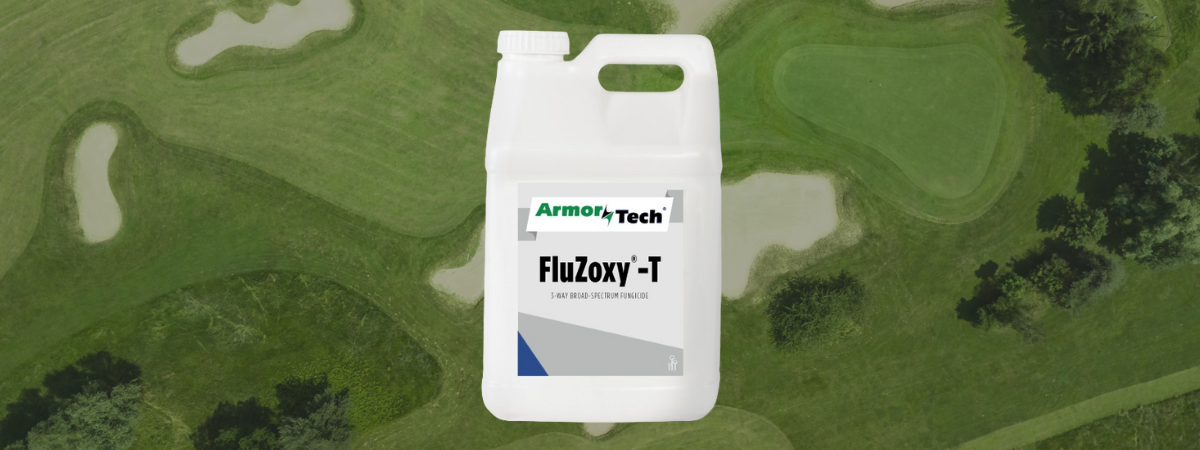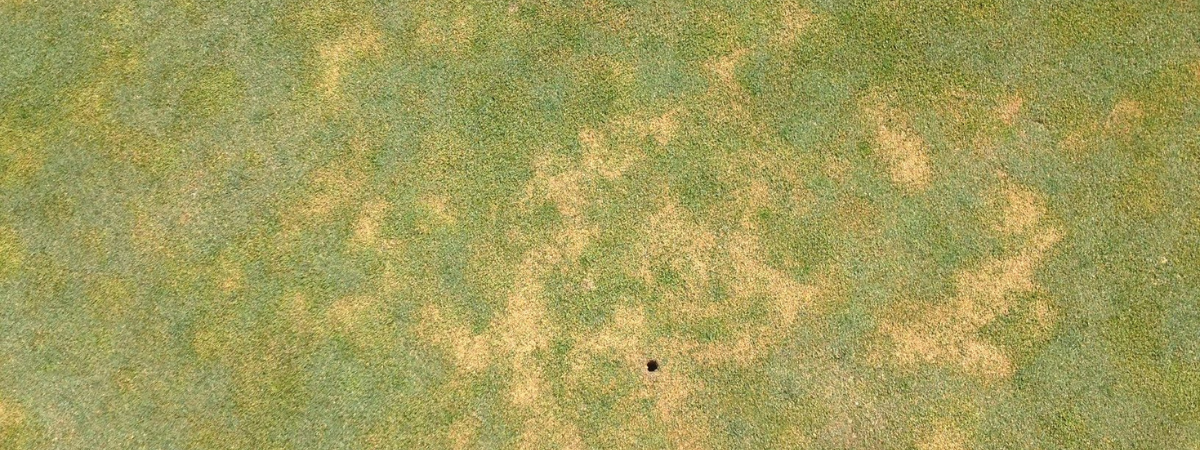Poa annua (or annual bluegrass) is an often misunderstood type of turfgrass. On the golf course, it can make for excellent putting greens—since it tolerates high-traffic and low-light conditions well. It does require special attention and care, especially in the summer. For superintendents managing Poa annua greens, here are a few major issues you may encounter, along with their respective solutions.
Turfgrass Diseases
Turfgrass diseases often pop up as summer begins, and Poa annua greens can be susceptible to many of them, especially:
Anthracnose
Anthracnose is a disease caused by the Colletotrichum cereale group of fungi, which affects the crown and roots of Poa annua. You can identify anthracnose through its telltale appearance: a general yellowing of the leaf blade and red leaf tip. Much like a camouflage pattern, an area affected by anthracnose will be splotchy with random areas of green and brown.
Apply DMI fungicides like Maxtima and Densicor when soil temperatures reach around 65°F at two inches. Some DMI fungicides can provide curative control, but preventative control is the best approach.
Dollar Spot
Dollar spot is a disease caused by the Clarireedia fungal genus. It causes small, circular brown or bleached patches to form on Poa annua greens. Dollar spots range between one and three inches in diameter and appear in close proximity to one another.
Dollar spot is active beginning in the late spring and into late fall, when air temperatures typically range from 60-90°F. Superintendents can fight dollar spot on their Poa annua greens by managing moisture properly and applying fungicides like Zoxy-T, PPZ 143 MC, and Lexicon. CLT 825, CLT 720, and TEB 360 XL are also good options.
Summer Patch
Summer patch, caused by the Magnaporthe poae fungus, harms turfgrass’ roots and crowns, leading to patches and rings of wilted, necrotic grass. The rings and patches will grow as the disease progresses, expanding from around one to three inches in diameter at the onset of symptoms to up to three feet in diameter once the disease has fully progressed. Below the surface, the roots and crowns will be discolored, appearing brownish-red or brown.
Proper irrigation and aeration can help combat summer patch, but targeted fungicide applications are the most important practice. Systemic DMIs and quinone inhibitors should be applied when soil temperatures reach the mid to upper 60s at two inches. A few recommended fungicides include Tourney EZ, and Patch Amino 5. DMI fungicides like Maxtima and Densicor, along with products containing tebuconazole, like FluZoxy-T, are good options, too.
Pest Problems
Pest management for Poa annua greens is going to center around insects—primarily grubs.
Annual Bluegrass Weevil
One of the biggest threats will be the annual bluegrass weevil (ABW). These small black beetles feed on Poa annua and can be hard to control. ABW damage will present as dry spots and thinning turf, which can appear similar to anthracnose damage. Superintendents should inspect the area more closely and look for beetles on the surface to determine the cause.
Once it’s been determined that there’s an ABW issue, season-long management will be necessary. ABWs can exist in adult form and larval form at the same time (multiple generations at once), making them a year-long problem. Preventative insecticides like Triple Crown, along with curative products like Arena, can control ABWs. To learn more about the ABW and additional control options, see our ABW blog post.
Grubs in General
Grubs tend to appear when water is introduced to the course, and, once their eggs hatch, they begin eating the roots. Grubs will eat the root system of the poa, which can kill the turf outright or make it more susceptible to disease, weeds, and drought conditions—neither of which are good outcomes.
Applying a preventative grub control product between July and August will keep grubs off your course. Curative options are available, but sticking to a schedule of preventative treatments will provide the best results. Learn more about grub control in our comprehensive grub control blog.
Heat Stress
Managing heat stress on Poa annua greens requires constant monitoring due to their relatively shallow roots. During high temperatures, superintendents should be on the lookout for a lack of moisture, and a moisture meter can help superintendents determine if the greens need to be watered. Time is of the essence when it comes to watering poa since its aforementioned root system isn’t as robust—or stress-tolerant—as other types of turfgrass. Read our heat stress blog post for tips on managing it.
Water Management
Managing water goes hand in hand with managing heat stress. Superintendents should water manually when needed and monitor/adjust their irrigation system run times. Constantly watching and adjusting irrigation systems when necessary is the best way to walk the tightrope between overwatering and turf damage due to lack of adequate irrigation.
Proper drainage and infiltration are important for maintaining healthy poa greens, too. Superintendents can ensure that water gets through the soil profile by using wetting agents (more on wetting agents in this blog post).
There are plenty of other practices that contribute to healthy turf, so if you have additional questions or are looking for some specific advice tailored to your course, reach out to your ATS rep. If you’re new to ATS or simply can’t remember your rep’s name off the top of your head, check out our rep finder tool and find them there!












